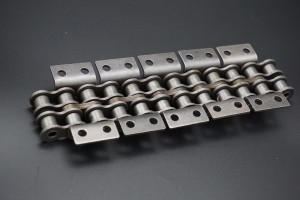Roller chains are key components in a variety of industrial and mechanical applications, playing a vital role in the smooth and efficient transmission of power and motion. These chains are widely used in industries such as automotive, agriculture, construction, and manufacturing for use in conveyor systems, power transmission, and other machinery. The key to a roller chain’s effectiveness lies in the role of the rollers, which are an integral part of its design and functionality.
A roller chain consists of a series of interconnected links, each with a set of rollers located between an inner and outer plate. These rollers play a key role in facilitating chain movement and reducing friction and wear during operation. Understanding the specific role of rollers in roller chains is critical to understanding their function and importance in various applications.
One of the primary functions of rollers in roller chains is to minimize friction and wear. As the roller chain moves, the rollers come into contact with the sprockets, which are the gears that drive the chain. The rollers allow the chain to rotate and move smoothly as it rolls along the sprocket teeth, reducing the friction that can occur when the links come into direct contact with the sprocket. This not only ensures efficient power transfer, but also helps extend the life of the chain and sprockets by minimizing wear.
Additionally, the rollers in roller chains are used to maintain proper chain alignment and engagement with the sprockets. The rollers help guide and support the chain as it moves along the sprocket, preventing the chain from wandering or pulling away from the sprocket. This is especially important in high-speed and heavy-duty applications where precise chain alignment is critical for reliable and consistent performance. Rollers play a key role in ensuring that the chain meshes securely with the sprockets, preventing slippage or misalignment that can lead to operational issues and downtime.
In addition to reducing friction and maintaining chain alignment, the rollers in roller chains also help improve the overall efficiency and smooth operation of the machinery they are used on. By allowing the chain to roll smoothly along the sprockets, the rollers help minimize energy loss and vibration, resulting in more efficient power transfer and lower noise levels. This is particularly beneficial in applications where precision, reliability and smooth operation are critical, such as industrial automation, material handling systems and power transmission equipment.
Additionally, the design of the rollers in a roller chain is critical to ensuring optimal performance and durability. Rollers are typically made from high-quality materials such as hardened steel or engineered polymers, which are chosen for their strength, wear resistance, and ability to withstand heavy loads and harsh operating conditions. In addition, the shape and size of the rollers are carefully designed to provide the right balance between contact area and rolling resistance, ensuring efficient power transmission while minimizing energy loss and chain and sprocket wear.
It is important to note that proper lubrication is critical for the efficient operation of rollers in roller chains. Lubrication helps reduce friction, dissipate heat, and prevent corrosion, thereby extending the life of the chain and ensuring smooth operation. Regular maintenance and lubrication of roller chains is critical to maintaining the integrity and performance of the rollers and the overall reliability of the machinery using the rollers.
In summary, the role of rollers in roller chains is integral to their functionality and performance in a wide range of industrial and mechanical applications. By reducing friction, maintaining chain alignment and increasing efficiency, rollers play a vital role in ensuring smooth and reliable power transfer and motion control. Understanding the importance of rollers in roller chains is critical to selecting the correct chain for a specific application and ensuring proper maintenance and lubrication practices to maximize the service life and performance of these important components.
Post time: May-04-2024

